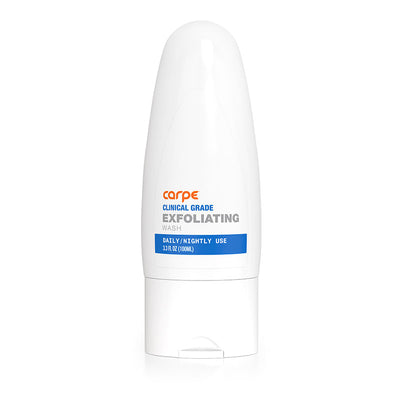Chances are if you are not a dermatologist or physician, you may not have heard the term intertrigo before. You may have heard or likely experienced some of its more common symptoms - thigh chafe, under breast rash, underarm irritation.
Intertrigo is a common type of inflammatory rash caused by skin rubbing against another plane of skin which creates friction. Both heat and moisture add stress to the affected skin. Under these conditions the body may initiate an inflammatory response and intertrigo can develop. More simply put, intertrigo often develops on areas of the body that are hot, moist and that rub together. For example, intertrigo is often found under breast tissue that’s been exposed to sweat and compounded by the use of a bra. Intertrigo often results in an uncomfortable reddish rash.[1]
The parts of the body that are most susceptible to intertrigo are places that frequently accumulate sweat and remain covered with fabric.
The areas that are most prone to developing intertrigo include:
- Armpits
- Breasts
- Groin
- Under the breasts
- Buttocks
- In between toes[2]
Some factors like obesity and living in a hot, humid climate can make it more likely for someone to develop intertrigo.[1]
Intertrigo in and of itself is not a serious problem, but it can lead to bacterial and fungal infections that can cause bigger problems if it’s not treated properly. Friction can cause skin to break open and exposes the body to potential infections. Microbes flourish in places that are dark, moist, hot and hard to keep clean.[1]
Symptoms of Intertrigo
Intertrigo often begins as a symmetrical reddish rash that can have bumps where the skin rubs.[1] If the rash is caught early and there’s no infection yet you may feel:
- Itchy
- Uncomfortable
- Burning
- Prickly sensations
- Pain[2]
If intertrigo persists the symptoms may progress and the skin can become raw. Eventually, cracking, bleeding and oozing can occur. However, this can be prevented if the rash is caught and treated in its earlier stages.[1,2]
If an infection occurs, different symptoms will appear. These often include:
- Bad smell coming from the affected area
- Development of bumps that contain pus
- Raised tender bumps[1]
Infection is a potentially serious consequence of intertrigo and you should speak with a doctor if you develop any of the symptoms discussed above.
Treatments
Luckily, intertrigo can be treated and later prevented. You should generally have a doctor check out an intertrigo rash to make sure it’s not infected. If an infection is present you may need antimicrobial medication in addition to treatment for the cause of the rash itself.[3]
The best treatment for intertrigo is to address the underlying problem that caused the rash to develop in the first place.[3] Managing intertrigo should also be done as gently as possible.[4] If the rash is not infected the following can be useful solutions:
- Antiperspirants that are non irritating can reduce moisture by preventing sweat build up. This can give skin a chance to heal and dry out.[3] Products like Carpe’s sweat absorbing breast lotion are good moisture managers that are less irritating and can help lead to dryness that will clear up intertrigo. Carpe has products for specific parts of the body which can be helpful as intertrigo can occur in several different places.
- Cleaning the area regularly with mild soap and then drying the rash with a soft towel is highly recommended. This will help keep the rash from becoming infected and allow skin to heal.[3]
- Keeping the area cool and reducing friction as much as possible will also improve symptoms. This can be done by wearing non restrictive clothing and staying in cool environments when possible.[3,4]
- Using a mild topical steroid solution to reduce inflammation can be useful in some cases. This can reduce inflammation.[4]
- Drying powders can also be useful for preventing intertrigo.[3] For example, Carpe has sweat absorbing groin powder that can help keep sweaty areas dry and prevent chafing.
If you have intertrigo it’s important to keep yourself comfortable and allow your body time to heal. It can be frustrating when the symptoms make you uncomfortable but intertrigo is usually manageable once you are able to keep the area clean and find the right product regimen for your situation.
References
- Intertrigo. Cleveland Clinic. (2021, August 24). Retrieved January 18, 2022, from https://my.clevelandclinic.org/health/diseases/21693-intertrigo
- Hecht, M. (2019, February 26). About Intertrigo Skin Rashes. healthline. Retrieved January 18, 2022, from https://www.healthline.com/health/intertrigo
- Nobles, T., & Miller, R. A. (2021). Intertrigo. StatPearls. Retrieved January 18, 2022, from https://www.ncbi.nlm.nih.gov/books/NBK531489/
- Janniger, C. K., Schwartz, R. A., Szepietowski, J. C., & Reich, A. (2005). Intertrigo and Common Secondary Skin Infections. American Family Physician. Retrieved January 18, 2022 from https://www.aafp.org/afp/2005/0901/p833.html






16790753702383.jpg?v=1679075372)

16790746985853.jpg?v=1679074700)


16790757289763.jpg?v=1679075731)









